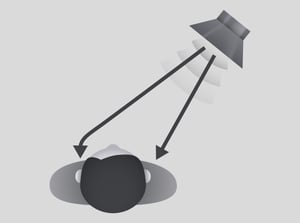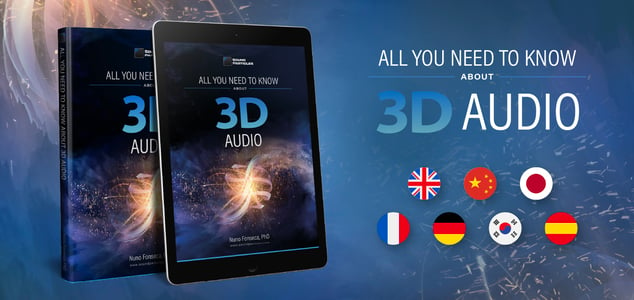We're almost there!
In this blog post, we will talk about the last topic of the "All You Need to Know About 3D Audio" series: binaural!
The reproduction of 3D sound using headphones is called Binaural audio, and it doesn’t require any special type of headphones, being a fundamental tool for anyone working in immersive sound. Let's dive into it!

When someone mentions immersive sound, most people automatically think of a room filled with speakers everywhere – in the front, the sides, above you, etc. Nevertheless, there is a special type of immersive sound approach that only requires a very simple setup: headphones.
But you're probably wondering: can I simulate 3D Sound with headphones?
Well, the truth is that everyone can experience 3D sound using only 2 ears, right?! I may be in a fully installed Dolby Atmos theater, surrounded by 64 speakers, listening to a fantastic sound experience, but in the end, my brain is only listening to two audio signals: my left and right ears. As such, it should be possible to reproduce a fully 3D sound experience using headphones.

So, does it mean that we can get realistic 3D sound over headphones for everyone? Unfortunately, not for everyone.
Each person has a different head, different ears, and other physical aspects that are unique to each one of us, which means that there will be slight variations in the way each person’s ears will affect the arriving sound. And each brain has spent many years listening to audio with those personal characteristics, not others.
We know that people perceive sound differently, its direction affects our ears, and we are talking about amplitude, time, delays, and filters. And this means you can create different responses from everywhere - the so-called HRTF (Head Related Transfer Function):
If I listen to some binaural audio, which was created with an HRTF dataset captured from someone else, I can either have a great experience with a perfect 3D sound or, my brain could have a difficult task, trying to interpret conflict information due to the physiological differences between me and the original HRTF person.
When you listen to music with your headphones, you will feel the sound coming from inside your head, with binaural you can externalize everything, you feel the sound coming from everywhere outside your head!
It’s important to refer again that binaural audio only works if reproduced with headphones. If you reproduce its audio with stereo speakers, you may eventually get an acceptable stereo sound, but not a 3D experience, or anything close.
It's also important to note that all the different approaches that we mentioned earlier – channel-based audio, object-based audio, and Ambisonics – can be converted to Binaural.

When to use each 3D Audio format?
Over the last blog posts, we learned all about the main flavours of 3D Audio: Channel-based Audio (from stereo to 5.1 and so on), Object-based Audio (understanding Dolby Atmos), Ambisonics (widely used in applications, especially in VR) and Binaural (3D sound over headphones).
All of these formats have advantages and disadvantages, there isn't a single format that is the best for all situations. This is probably not the answer you were looking for but the truth is, we have to open our minds and find our perfect fit!
Each situation is different, for some channel-based audio is the best but for others binaural can be the perfect match! The secret? If you're able to understand the pros and cons of each one, you have the secret to taking the best out of them!
However, it's also possible to mix them using hybrid approaches. For example, in Dolby Atmos, we have object-based audio and channel-based audio working together. Or, you can convert Ambisonics to Binaural, it all depends on the project you're working on and the experience you want to offer.
Our "All You Need to Know About 3D Audio" series comes to end but we want to know your thoughts and experiences with 3D Audio!
Welcome to this fantastic world 🎧
Did you know our free eBook "All You Need to Know About 3D Audio" is now translated into 4 new languages?

After the success of the English, Chinese and Japanese versions, Sound Particles brings four more translations, French, German, Korean and Spanish, to help professionals around the world to transition into the immersive audio field. With this free eBook, sound enthusiasts will be able to find all the answers they’re looking for in a detailed, complete and easy-to-read guide.
If you want to be the first to get all the fresh news, subscribe to our Newsletter!
.png?width=839&name=blog-newsletter-banner%20(2).png)
Topics: Sound Particles, Audio Software, Sound Design, Film, Sound for Film and TV, Audio tech, 3D audio, Surround Sound, Gaming Audio, Webinars
